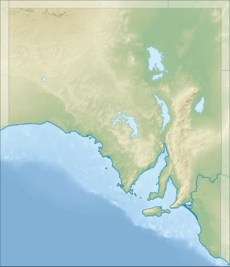Big Heath Conservation Park facts for kids
Quick facts for kids Big Heath Conservation ParkSouth Australia |
|
|---|---|
|
IUCN Category Ia (Strict Nature Reserve)
|
|
| Nearest town or city | Naracoorte |
| Established | 7 May 1964 |
| Area | 24.72 km2 (9.5 sq mi) |
| Visitation | 'low' (in 1994) |
| Managing authorities | Department for Environment and Water |
| Footnotes | Nearest town |
| See also | Protected areas of South Australia |
Big Heath Conservation Park is a special protected area in South Australia, Australia. It's located about 20 kilometers (12 miles) southwest of Naracoorte. This park is part of the beautiful Limestone Coast region. It helps protect the unique plants and animals that live there.
Contents
About Big Heath Conservation Park
Big Heath Conservation Park is found in an area called Spence. A water channel, known as 'Drain M', runs through the park's southeast corner. This drain helps move water from Bool Lagoon to the sea at Beachport.
History of the Park
The land for Big Heath Conservation Park first became a protected area on May 7, 1964. Back then, it was called a "wild life reserve."
A few years later, on November 9, 1967, it was officially named the Big Heath National Park. In 1972, its name changed again to Big Heath Conservation Park. This happened when a new law, the National Parks and Wildlife Act 1972, was created.
Over the years, more land has been added to the park. In 1993, another section was included. Then, in 2010, a piece of land called Allotment 500 was also added. As of 2016, the park covers about 24.72 square kilometers (9.54 square miles).
Plants and Trees in the Park
Big Heath Conservation Park has many different types of plants. These plants grow in different areas depending on the soil and how high the land is.
Different Plant Zones
- Higher Land: In the park's northeast, there's higher land with special red soil called "terra rossa soils." Here, you'll find eucalypt woodlands with not many plants growing underneath the trees.
- Sandy Areas: The northwest part of the park has deep sandy soil. This area has a "low woodland" with trees like brown stringybark and pink gum. The main plants growing beneath them are desert banksia.
- Limestone Outcrops: Throughout the park, there are areas where limestone rocks stick out of the ground. These spots are home to trees like manna gum, South Australian blue gum, and pink gum.
- Wet Depressions: Some parts of the park have deep dips in the ground that often don't have trees. These areas are surrounded by sedges (grass-like plants).
- Deeper Wet Spots: In the southeast, deeper dips are surrounded by River Red gum trees.
- Shallower Wet Spots: Other shallower dips are surrounded by a thick "heath" of plants like mallee honeymyrtle, yellow hakea, and prickly tea-tree. As the ground gets a bit higher, you'll find broombush, grass tree, and dwarf Sheoak.
Introduced Plants
About 20% of the plant species found in the park are not native to Australia. These are called introduced species. One of the biggest concerns is a plant called boneseed, which is considered a harmful weed.
Visitors and Conservation
In 1994, it was noted that not many people visited the park. Most visitors were local people or those from Naracoorte who came to study nature.
The park is classified as an IUCN Category Ia protected area. This means it's a very strict nature reserve, set aside mainly for scientific research and to protect its wild nature.


